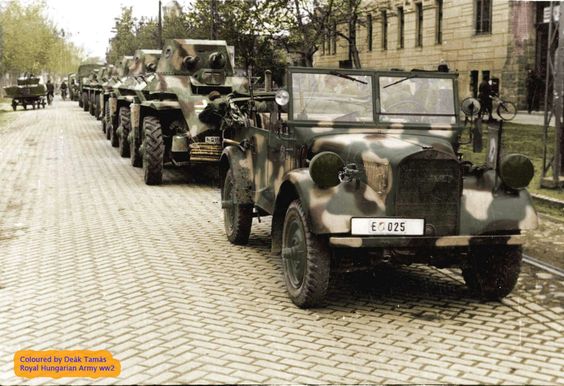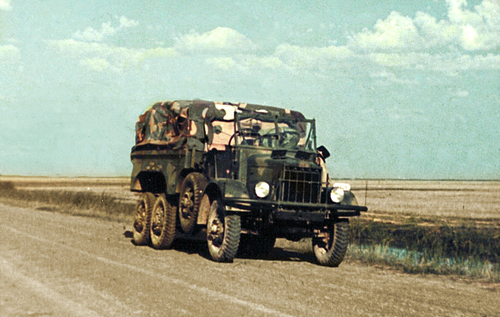Infantry support and transport vehicles used by the Hungarian Army
- Jacky 95
- Apr 12, 2018
- 9 min read
Diamler-Benz G5
Krupp Protze
Had at least two versions. A troop transport, and a commander version.
In the troop transport version the 2 bench seats are parallel with the side of the truck and there usually is a Solothurn or a Schwarzlose machinegun on a tripod. Both machineguns fired with 730m/s velocity. The Solothurn fired at 600rpm with 20-30 rounder box magazines,the Schwarzlose fired at 580rpm fed by 100-250 rounder canvas belts. Both used the same AA sight. More information, in the Infantry weapons post.
In the commander version there is no machinegun and the seats are positioned in a normal fashion.
The upper 1/3 of the tripod was welded to the front armor plate in the Krupp-Protze
Botond
In August, 1938, designer Dezső Winkler - Rába's worker - showed his prototype vehicle to the Hungarian military high command, which was based on the Rába AFi. Suprisingly the new design was much cheaper, simpler but more realible and capable than the German ones and was immediately accepted - the vehicle was put into service as the "38.M Botond" or later "38.M Botond A". Later in the war the vehicle had further developments. Its engine was slightly upgraded and the steering-wheel was placed from the right side to the left - the new design was named "38/42.M Botond B". The 6x4 powered, 3 axial Botond all-terrain truck's first axle was not driven only the two rear ones were the driven shafts. It had a long-travel suspension, each driven wheel had independent double-swingarm wishbones, but axle groups on the same side, in pairs on a rocker system were still able move significantly in relation to each other.
The Botond had 2 "crutch-wheels" behind the driver's cabin - these spare wheels were on a non-driven axle which could be lowered, the spare wheels were not fixed but could rotate.
The "crutch-wheels" prevented that the truck would stuck on the peak of a hill, they helped it to roll over the peak. The vehicle also had 2 rollers on its frontal bumpers which also increased its off-road capabilities because they helped the truck to get out of ditches. It also had built-in winch. The simple design of the engine also made it the Axis' most realible vehicle on the whole Easter Front. Actual military reports from 1941 state that where other vehicles - even the technologically superior German ones - failed the Botond was still operational, be it on a muddy road or deep snow. Even today the Botond's off-road capabilities are legendary. The only problem it had was its relatively weak 65 hp (48.5 kW) - later 70 hp (52.2 kW) in the 38/42.M Botond B - engine, even the designers said that the vehicle would be perfect if it had a stronger engine. For this they started to design the "Botond C" with 100 hp engine but they didn't had enough time to finish it. However we still know some field-modifications where Hungarian engineers replaced the Botond's original engine with an abandoned German vehicle's and the truck ran perfectly.
The Botond was a 1,5 tonn truck which was mainly used for troop transport but later it towed anti-tank guns and the 40mm 36.M Bofors AA autocannons too. Today we know of only one survivor, a 38/42.M Botond B truck which was displayed in the Hungarian Technical and Transportation Museum in Budapest from 1960. It was renewed in 1995 and since 2011 it can be seen in the Rába factory's museum in Győr.
General
name: 38.M Botond A or 38/42.M Botond B
number built: 2554
type: all-terrain truck
year: 1939-1944
length: Botond A: 5,650m
Botond B: 5,700m
width: 2,080m
height: 2,550m - 0,300m from the ground
wheel: 210x20
tire pressure: ? kg/cm2
max climb: 22,22%
step: ?m
trench: ?m
ford: 0,7m
turning radius: ?m
max weight: Botond A: 3,950t (own weight)+1,5t off-road or 2t on road
Botond B: 4t (own weight)+1,5t off-road or 2t on road
radio: -
crew: 6 (driver, commander, gunner, 3xloader)
max speed: 60 km/h on road
ENGINE
name: ?
power: Botond A: 65 hp a 2500 rpm
Botond B: 70hp a 2400 rpm
power-to-weight ratio: Botond A: 16,45 hp/t (with own weight)
Botond B: 17,5 hp/t (with own weight)
engine displacement: Botond A: 3771cc
Botond B: 4330cc
gears: 5 + 1
max speed 5th gear: 60 km/h
max speed reverse gear: ?
fuel: petrol
fuel capacity: 125L
autonomy: Botond A: 400km on road, 300km off-road
Botond B: 380km on road, 280km off-road
HULL
armour thickness and slope: 3mm
GUN
type: 07/31.M Schwarzlose MG
caliber: 8x56mmR
length: 0,945m (0,530m barrel)
weight: 19,6kg
depression/elevation/traverse: ?°
max ammo: ? in 250-rounds metal belts
rate of fire: 580/min
type of rounds: 31.M élestöltény (ball-cartridge), 31.M magvas töltény (armor-piercing cartridge), 31.M fényjelző töltény (tracer cartridge)
MUNITIONS
name: 31.M élestöltény (ball-cartridge)
weight: 27,6g (cartridge), 13,4g (projectile)
type of filling and weight: 3g gunpowder
muzzle velocity: 730m/s
Penetration (100m,500m,1000m): ?
name: 31.M magvas töltény (armor-piercing cartridge)
weight: 26,7g (cartridge), 12,4g (projectile)
type of filling and weight: 3g gunpowder
muzzle velocity: 730m/s
Penetration (100m,600m): 10mm, 6mm at 0°
name: 31.M fényjelző töltény (tracer cartridge)
weight: 25,5g (cartridge), 11,4g (projectile)
type of filling and weight: 3g gunpowder
muzzle velocity: 730m/s
Penetration (100m): 6mm at 0°
Hungarian 44.M Rába Maros truck
During the war Hungary desperately needed 3 tonn trucks since the German import Fords were not enought and the Krupp trucks were not delivered in 1941-43. Therefore the engineers at Rába used parts of the succesful Rába Botond, Rába AFi and Rába Super trucks therefore there was no need for a completly new design to be developed.
The new vehicle was named as K-III at that time which changed later to "Maros".
The prototype was tested on April, 1943, and proven to be a succesful design even when only the rear wheels were driven.
The truck had a 70 hp (52.2 kW) engine and could reach a max. speed of 65 km/h and had 8 square meter platform on which it could carry 3000 kg. However the first vehicles were produced only in January, 1944, because of material shortage, and because of the constant Allied Air Raids only 350 vehicles were made. Because it was a reliable vehicle it was still used by both the Army and in the civilian life in the communist regime which is proven by photos, however - as with the Botond - the later government and Soviet rule wanted to get rid of anything Hungarian therefore the Maros became a victim of this "witch-hunt".
Hansa -Lloyd artillery truck
As the name implies, it was used as an artillery towing truck.
43.M Lehel armored personnel carrier
In 1941 the Hungarian Ministry of Defence ordered the Institute of Military Technology (HTI) to plan an armored wounded and personnel carrier based on the 36/40.M Nimród SPAAG's chassis. The MÁVAG company studied these plans and said that it would be able to produce the vehicle on the same price as the Nimród which was too much of a price, therefore the plans were halted. In 1943, however, the HTI cleared the dust from the blueprints again since Hungary was in a desperate need for an armored all-terrain medical vehicle.
The HTI made some changes of its plan, thus the new vehicle was able to carry 4 seriously injured, lying and 2 lightly wounded, sitting soldiers and a field doctor. The new model had 2-2 strechers on each side, above each other. Those stretchers which were not used could be slipped next to the side armor. Under the sterchers there were seats for 4-4 people on both sides, the seats could be opened revealing the cargo space for equipments. Two guide rails on the engine compartment made it easier to put the strechers inside the vehicle.
This version of the carrier was named 43.M Lehel S.
The troop carrier version of the Lehel was capable to transport 7 sappers with their full marching equipment which was quite big, therefore 11 foot soldiers could fit inside. The vehicle was made by Mávag on July 15, 1943, tests were done in the same month. The military professionals wanted slight changes on the vehicle: a built in light machine gun, closable observation-slits on the side armor and other small modifications. The MÁVAG company finished the changes on the carrier on August 16, 1943, and another series of tests were done between August 30 and September 14, 1943. The troop carrier version of the vehicle was named 43.M Lehel Á.
The armor of the vehicle was max. 20mm, the height changed to 1.95 meter, all other features were the same as the Nimród's. With the successful tests the Ministry of Defence ordered a series of both types from MÁVAG, they wanted 9 Lehels to be made from the already manufactured Nimród series and ordered another 28 Lehels above the Nimród series. However there were other vehicles which were higher in priority and the Royal Hungarian Armed Forces lost a lot of Nimróds on the front lines, therefore no other Lehels were produced.
Hungarian Méray-J.A.P. motorbikes
Designed by the Méray-Horváth brothers, Lóránd and Ede. They were the fisrt ones in Hungary who manufactured motorbikes from 1923. Their enterprise was part of the Magyar Acélárugyár Rt. (Hungarian Steelworks Factory Ltd.) and their motorbikes consisted many import parts, most notably the British J.A.Prestwich and Company motorbike engines. It was common that the Méray-J.A.P. motorbikes in civilian use were painted in black, while the ones used by the Armed Forces and Gendarmerie were green, the Police used chrome colored bikes while the Fire Departments painted their bikes in red.
32.M Méray-JAP KK31 500 SV:
The Méray-JAP 500 which was developed at the beginning of the 30s for military purpose - used a four-stroke cycle, one cylinder in-line, sidevalve J.A.P. engine with 500 cc capacity, and 12 hp (8.95 kW). The motorbike could reach a top speed of around 90 km/h, it had 3 gears. This motorbike was used by the Royal Hungarian Armed Forces in WW2. Although it was more powerful than the Méray-JAP KK31 350 SV it was still not powerful enough to have a sidecar. The motorbike was modernized in 1937.
28.M Méray-J.A.P 1000 SV :
This motorbike was designed in 1928 but was still used in WW2 because it was quite realible and hard-wearing. The Méray-JAP 1000 used a four-stroke cycle, two cylinders in V-formation, sidevalve J.A.P. engine with 1000 cc capacity, 22 hp (16.2 kW). The motorbike could reach 100-120 km/h max.speed, had 3 gears and it was used by the Royal Hungarian Army, Gendarmerie, Police and Fire Departments in the interwar period and WW2. It was the only Hungarian motorbike which was powerful enough to have a sidecar too.
Hungarian armed motorcycles
During WW2 Hungary used many motorbike companies in Reconnaissance Battalions and as sub-units of the Motorised Rifle Brigades - later Regiments. Some of these motorbikes were equipped with 8mm 31.M Solothurn light machine guns, 8mm 07/31.M Schwarzlose machine guns, 20mm 36.M Solothurn anti-tank rifles or even 50mm 39.M grenade launchers. These weapons could be dismounted from the side car of the motorbike but were also operational while mounted on it and the vehicle moved. The horizontal and vertical movements were limited of course.
Based on the pictures the Royal Hungarian Army used these weapons on multiple motorbikes and used different mounts in some cases. For example the 20 mm 36.M Solothurn anti-material rifle mount on a BMW R.75 sidecar and on a PZInż Sokół 1000 sidecar differs.
This goes for the 8 mm 31.M Solothurn light machine gun too. On a BMW R.75 the bipod of the LMG is fixed to the sidecar meaning that the 31.M Solothurn LMG there was a later variant where the gun barrel could move freely on a bipod. The early variants of the 31.M Solothurn LMG had fixed bipods on the barrels, the gunner could not rotate it to any direction without re-positioning the gun again. For these early 31.M Solothurn LMGs the Royal Hungarian Army used a different mount (seen in picture No.3).
For a Schwarzlose machine gun mount I also couldn't find a Hungarian example only an Austrian Bundesheer example but it's also proved by archive documents that 8 mm 07/31.M Schwarzlose machine gun mounts for motorcycle sidecars were used too in the Royal Hungarian Army.
I also could not find a photographic example for the sidecar mounted 50 mm grenade launcher but according to archive documents it was used and in 1944 it was also issued to BMW R.75 motorbikes.
Other trucks used by Hungary in WW2 (many were taken from companies and enterprises to fulfill Army requirements): - Hungarian Rába V (licence built Praga V) - Hungarian Rába AFa - Hungarian Rába AFe - Hungarian Rába AFh - Hungarian Rába-Krupp L 3.5H 63 (licence built Krupp) - Hungarian Rába-Krupp L 3.6H (licence built Krupp) - Hungarian MARTA (Magyar Automobil Részvénytársaság/Hungarian Automobile Ltd.) truck (WW1 era truck) - Hungarian MÁVAG-Mercedes LO 2000 (licence built Mercedes-Benz) - Hungarian MÁVAG-Mercedes LO 2500 (licence built Mercedes-Benz) - German Henschel Typ 33 D1 - German Klöckner-Deutz 330 A/S - German Krupp L2 H.43 „Krupp-Protze” (Hungarian superstructure on German chassis) - German Krupp L2 H.143 „Krupp-Protze” (Hungarian superstructure on German chassis) - German Magirus 3000 - German Mercedes-Benz L3000 A/S - German Mercedes-Benz L4500 A/S - German O.D.-Rex 4 Eintonner - German Opel-Blitz Type 3,6-36S & 6700A - German Opel-Blitz (2.5t) Ambulance - German Phänomen Granit - Austrian Gräf&Stift - Czechoslovakian Praga RV - Czechoslovakian Škoda 256 Ambulance - Czechoslovakian Škoda 256B - Italian OM Autocarretta 32 - Italian FIAT 4Ts - Italian FIAT XV - Italian FIAT 6M Autocarretta - Italian FIAT SPA Dovunque 35 - Italian FIAT SPA 38R - American Ford BB (Köln) - American Ford V8/51 (Köln) - American Ford 817T (USA) - American Ford-Marmon V8 (USA) - American Ford V. 3000S (Köln) - Looted Polish Polski Chevrolet COE „Bulldog” Omnibus - Looted Polish Polski Fiat 621 L























































































Comments